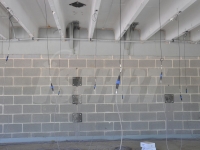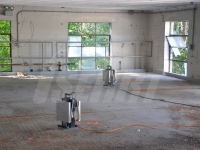Unique access to an industrial building prior to, during, and immediately after detonation of an internal explosion was leveraged to obtain a remarkably extensive database of experimental measurements on the performance of the building before and after damage induced by the blast loading. Additionally, incident pressures, reflected pressures, and shock accelerations across various structural surfaces were obtained during the blast to quantify the loading and structural response. The structure tested was a two-story masonry building that advantageously provided opportunities to test the performance of a prestressed double-tee joist roof, conventional masonry walls, and an interior steel frame under blast loading.
Key features of the experimental database are:
- Multiple-Input-Multiple-Output Modal Testing of the Prestressed Double-Tee Joist Roof using a stationary array of 60 accelerometers distributed across the 12 joists during application of controlled, measured excitation produced by 2 long-stroke shakers driving reaction masses.
- Multiple-Input-Multiple-Output Modal Testing of an Internal Steel Frame using a stationary array of 58 accelerometers distributed across columns and primary beams during application of controlled, measured excitation produced by 2 long-stroke shakers driving reaction masses.
- Modal Testing of an Infill Masonry Wall by Roving Impulse Hammer Technique over 48 locations of the wall with multiple stationary accelerometers to extract modal parameter estimates of the wall prior to and after blast loading.
- Materials Characterization through Impact-Echo Technique applied at over 1500 locations across the prestressed roof joists.
- Collection of Physical Test Specimens for Destructive Testing including cores from the concrete in the roof and cores from the masonry blocks.
- Blast Observation and Measurement from high-speed synchronous data acquisition of 2 incident pressure pencil probes, 10 flush-mount reflected pressure transducers, and 8 shock accelerometers distributed across the prestressed concrete roof, masonry walls, and steel frame.
Publications
Kernicky, T., Whelan, M.J., and Weggel, D. (2014) “Experimental Modal Analysis of a Prestressed Concrete Double-Tee Joist Roof Subject to Blast,” International Modal Analysis Conference XXXII, Orlando, FL, February 2-5, 2014.
Whelan, M.J., Kernicky, T., and Weggel, D. (2014) “Structural Identification using the Applied Element Method: Advantages and Case Study Application,” International Modal Analysis Conference XXXII, Orlando, FL, February 2-5, 2014.
Kernicky, T. (2013) “Structural Identification and Damage Characterization of a Full-Scale Masonry Building Subject to Internal Blast Load,” Masters of Science Thesis, Department of Civil and Environmental Engineering, University of North Carolina at Charlotte.
Kernicky, T., Whelan, M.J., Rice, C., and Weggel, D. “Structural Identification of a Full-Scale CMU Infill Wall Subjected to Blast Loading using an Applied Element Framework,” International Workshop on Structural Health Monitoring (IWSHM), Stanford, CA, September, 2013










